Dinos' Veggie Diets Packed Surprising Punch Live Science - February 6, 2008
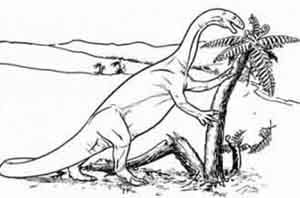
Dinos' Veggie Diets Packed Surprising Punch Live Science - February 6, 2008

Modern Birds Existed Before Dinosaur Die-Off National Geographic - February 10, 2008
"Amazing" Dino Fossil Found With Skin, Tissue in China National Geographic - January 16, 2008
 UK Dino Ate More Like a Croc National Geographic - January 14, 2008
UK Dino Ate More Like a Croc National Geographic - January 14, 2008
Big Dinosaurs Had "Teen Sex" National Geographic - January 14, 2008
Dinosaur Had Crocodile-Like Skull National Geographic - January 14, 2008
New meat-eating dinosaur unveiled BBC - December 12, 2007
New Dinosaur Discovered in Antarctica Live Science - December 11, 2007

Massive Dinosaur "Graveyard" Discovered in Spain National Geographic - December 10, 2007
Were Dinosaurs Colorful? Live Science - December 8, 2007
How Did Dinosaurs Communicate? Live Science - December 6, 2007
How Old Were the Oldest Dinosaurs? Live Science - December 5, 2007
Dinosaur Tracks Discovered in Utah Live Science - December 3, 2007
Dino Quiz: Test Your Smarts Live Science - December 3, 2007
How Do Dinosaurs Get Their Names? Live Science - December 3, 2007
"Dinosaur Mummy" Found; Has Intact Skin, Tissue National Geographic - December 3, 2007
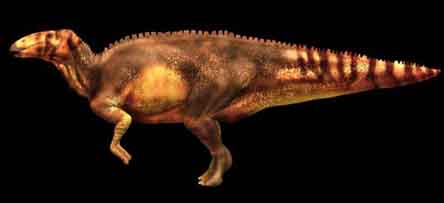
North Dakota: Amazing find of dinosaur 'mummy' BBC - December 3, 2007
Fossil hunters have uncovered the remains of a
dinosaur that has much of its soft tissue still intact.
Bizarre Dinosaur Grazed Like a Cow, Study Says National Geographic - November 15, 2007
Dino With "Vacuum Mouth" Revealed National Geographic - November 15, 2007
Fossil is new family of dinosaur BBC - November 15, 2007
Giant Dinosaur Skeleton Found in Museum Drawers Live Science - November 14, 2007

Polar Dinosaurs Left Their Tracks Live Science - October 19, 2007
'Giant dino' found in Patagonia BBC - October 16, 2007
Giant Dino Found in Fossil ''Lost World'' National Geographic - October 16, 2007
Big Waddling Dinosaur Discovered Live Science - October 4, 2007

A strange, long-necked waddling dinosaur with massive
arms and probably enormous claws has been discovered.
"Missing Link" Dinosaur Discovered in Montana National Geographic - October 3, 2007

Utah: Duck-billed dinosaur had big bite BBC - October 3, 2007

"Jurassic Park" Raptors Had Feathers, Fossil Suggests National Geographic - September 21, 2007
New "Mini" Dinosaur a Step in Bird Evolution Path National Geographic - September 6, 2007
Far-Flung Crash May Have Created Dino-Killer Asteroid National Geographic - September 6, 2007
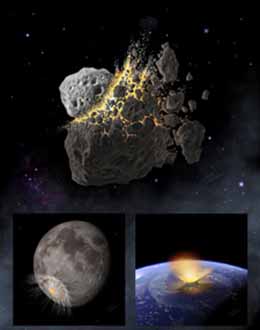
Bug Warfare Discovered in Dinosaur Era Live Science - September 4, 2007
The discovery of a bug that roamed with the dinosaurs has shown that
insects were equipped with chemical weapons much earlier than thought.
Scientists reveal the moving secret of Tyrannosaurus rex on computer Guardian - August 22, 2007
Dinosaur mass grave found in Switzerland MSNBC - August 9, 2007
Dinosaurs' slow rise to dominance BBC - July 20, 2007
Dinosaurs' Rise Was Slow, Not "Lucky Break," New Fossils Suggest National Geographic - July 20, 2007
Dinosaurs Had Sex As Youths, Study Says Live Science - July 20, 2007
Dinosaur Fossils Part of Longtime Chinese Tonic National Geographic - July 16, 2007
Meep-Meep! 'Road Runner' Dino Discovered Live Science - June 23, 2007
Dinosaur Extinction Spurred Rise of Modern Mammals, Study Says National Geographic - June 20, 2007
Massive Birdlike Dinosaur Unearthed in China National Geographic- June 13, 2007
Prehistoric Gliding Lizard Discovered in U.S. National Geographic - June 13, 2007
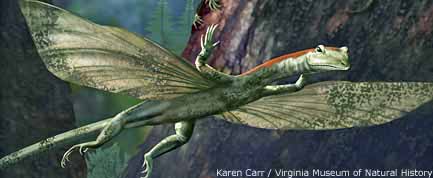
Fossil traces deep dinosaur roots - about 210 million years ago BBC - June 13, 2007
Big Dinosaurs Could Hear Only Low-Pitched Sounds, Experts Suggest National Geographic - June 8, 2007
T. rex was 'slow-turning plodder' BBC - June 5, 2007
"Feathered" Dinosaur Was Bald, Not Bird Ancestor, Controversial Study Says National Geographic - June 2, 2007
T. Rex, Other Big Dinosaurs Could Swim, New Evidence Suggests National Geographic - May 29, 2007
Tyrannosaurus Rex And Mastodon Protein Fragments Discovered, Sequenced Science Daily - April 12, 2007
Dinosaur Soft Tissue Sequenced; Similar to Chicken Proteins National Geographic - April 12, 2007
Protein links T. rex to chickens BBC - April 12, 2007
Fossil reveals a caring, sharing dinosaur Guardian - March 21, 2007
Digging Dinosaur Discovered Inside Fossil Den National Geographic - March 22, 2007
Dinosaur den diggers discovered BBC - March 21, 2007
The fossil remains of small dinosaurs that burrowed into
the ground have been found by scientists in Montana, US.
Triceratops' "Granddaddy" Discovered in Canada National Geographic - March 6, 2007
Over 100 Dinosaur Eggs Found in India National Geographic - February 6, 2007

Two Skeletons Push Primates Closer to Dinosaur Era Live Science - February 5, 2007
Flying dinos had bi-plane design BBC - January 22, 2007
Ancient Reptile Had Two Heads Live Science - January 19, 2007

Two-headed reptile fossil found BBC - December 20, 2006

Scientists have found what is thought to be the first
example of a two-headed reptile in the fossil record.
Europe's "Biggest Dino" Discovered in Spain National Geographic - December 21, 2006
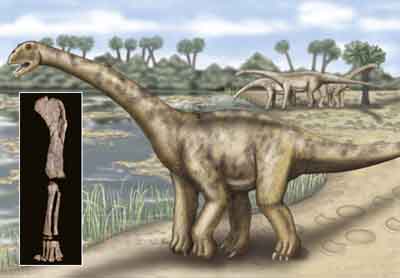
Baby Dinosaur Buried by Volcano Live Science - December 11, 2006
A massive volcanic blast may have killed and preserved a baby dinosaur,
whose skeleton, one of the most complete example of its kind ever found,
was recovered from the frozen ground of Antarctica.
Baby plesiosaur bones found in Antarctic China View - December 13, 2006

Giant Dinosaur Found in Argentina National Geographic - July 28, 2006
Flying reptile mystery 'solved' BBC - July 27, 2006
T. rex struggled with midlife crisis MSNBC - July 14, 2006
For Tyrannosaurs, Teen Years Were Murder National Geographic - July 14, 2006
Bigger dinosaurs had warmer blood BBC - July 11, 2006
Dinosaur-Era Birds Surprisingly Ducklike, Fossils Suggest National Geographic - June 15, 2006

110 million-year-old birds bridge gap between age of dinosaurs and today
A new species of mini-dinosaur has been unearthed in northern Germany BBC - June 7, 2006

North Sea fossil is deepest dino BBC - April 27, 2006
The first dinosaur fossil discovered in Norway is also the
deepest one that has been found anywhere in the world.
Norway: The World's Deepest Dinosaur Finding - 2,256 Metres Below The Seabed Science Daily - April 25, 2006
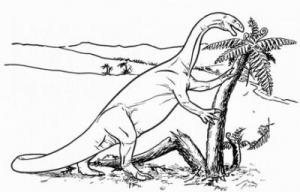
Meat-Eating Dinosaur Was Bigger Than T. Rex National Geographic - April 18, 2006
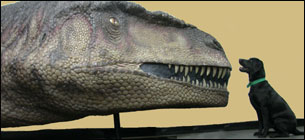
Huge dinosaurs roamed Argentina in groups BBC - April 18, 2006
Bringing Back the Brontosaurus Wired - April 5, 2006
Digging for fossils is for dinosaurs. Today's animal trackers
are using genomics to reconstruct - and one day resurrect -
the original hot-blooded beast.
Utah: Dino Looked Like 7-Foot Turkey Live Science - April 5, 2006
Long-neck Dinosaur Sets New Standard Live Science - March 20, 2006
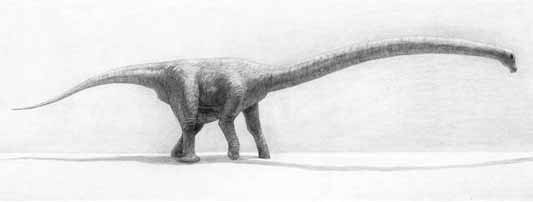
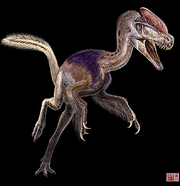
T. Rex's Oldest Ancestor Discovered in China National Geographic - February 8, 2006
Oldest T. rex relative unveiled in China BBC - February 8, 2006
Crocodile ancestor found in museum basement National Geographic - January 25, 2006

210 million-year-old fossil discovered by accident after decades in storage
A study of fossil dinosaur dung has for the first time confirmed that the ancient reptiles ate grass BBC - November 17, 2005
Remains of 'Godzilla' croc found in Argentina BBC - November 11, 2005
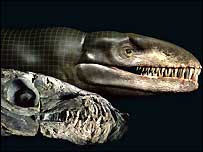
Velociraptor Dino made famous by the "Jurassic Park" movies not so vicious National Geographic - October 20, 2005
Dinosaur Swam for Its Dinner Scientific American - October 20, 2005
China: Ancient Flying Reptiles Discovered National Geographic - October 5, 2005

Plesiosaurs ate snails and clams News in Science - October 8, 2005
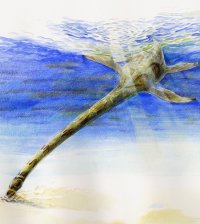
Rare Fossil Embryos Reveal Dinosaur Growth National Geographic - July 29, 2005
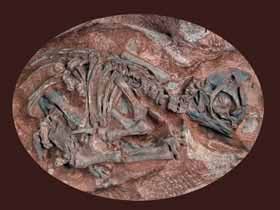
Experts tell Mr from Mrs dinosaur BBC - June 2, 2005
First Ever Fossil Of Sleeping Dinosaur Found In China Science Daily - May 23, 2005

Arachnid's clue to dino wipeout BBC - May 18, 2005
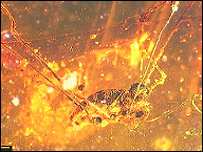
New Views of Dinosaurs Take Center Stage
Scientific American - May 16, 2005
Utah: Killer dino 'turned vegetarian' BBC - May 4, 2005
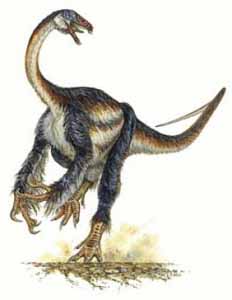
Eggs found inside dinosaur fossil BBC - April 2005
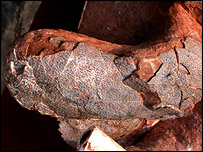
T. rex fossil has 'soft tissues' BBC - March 2005
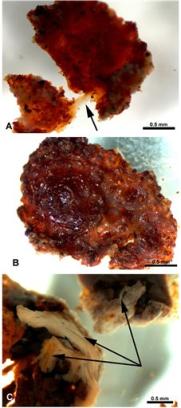
For more than a century, the study of dinosaurs has been
limited to fossilized bones. Now, researchers have recovered
70-million-year-old soft tissue, including what may be blood
vessels and cells, from a Tyrannosaurus rex.
Fierce badger-like mammals ate dinos for lunch BBC - January 2005
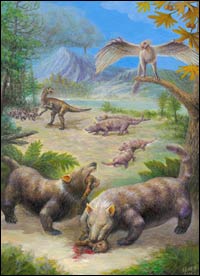
New dinosaur uncovered in Brazil BBC - December 2004
Fossil Egg Finds Yield Clues to How Pterosaurs Lived National Geographic - December 2004

Britain's biggest dinosaur found - Isle of Wight BBC - November 2004 The long-necked sauropods were the biggest and heaviest group of dinosaurs in existence.
Debating the Dinosaur Extinction Astrobiology - October 2004
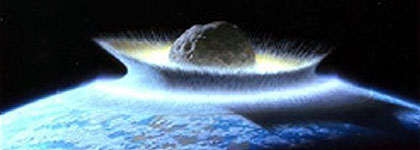
At least 50 percent of the world's species, including the dinosaurs,
went extinct 65 million years ago. While most scientists now
blame this catastrophe on a large meteorite impact,
others wonder if there is more to the story.
'Sleeping dragon' had bird repose BBC - October 2004
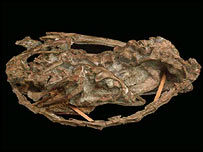
A 130-million-year-old fossil dinosaur caught apparently grabbing a
kip with its head tucked under its forearm has been discovered by
Chinese scientists. It is the earliest known example of an animal
unearthed in a bird-like repose. Mei long, which means
"soundly sleeping dragon", was pulled out of the famous fossil
beds of Liaoning province.
Pre-Dinosaur Reptile Discovered - Long-Necked Hunter National Geographic - September 2004
Long-necked hunter found in China BBC - September 2004


The remains of a 230-million-year-old marine reptile with
fangs and a long neck have been found in southeast China.
Fossil hints at devoted parenting in dinosaurs Nature - September 2004
Fossil hunters in China have unearthed what looks like the
final resting place of an adult dinosaur with 34 offspring.
The unique discovery shows that at least some dinosaurs
cared for their young after they hatched out, and suggests
that the parental instincts of present-day birds and reptiles
such ascrocodiles may have a common evolutionary precursor.
Growing Pains: T. Rex had a massive growth spurt during its adolescent years Science Daily - August 2004
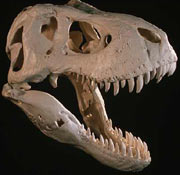
Dinosaur-Era Bird - Archaeopteryx - Could Fly, Brain Study Says National Geographic - August 2004
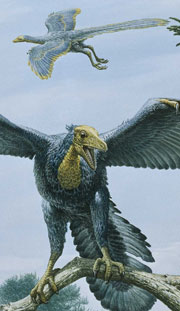
The fossilized brain of a 150 million- year-old bird has
given up the secret of whether or not the creature could fly:
apparently it could, say experts.
Dinosaur Tooth Found in Flying Reptile's Spine National Geographic - June 2004
Two Dinosaurs From Africa Give Clues To Continents¹ Split Science Daily - June 2004
Two Dinosaurs From Africa Give Clues To Continents¹ Split Science Daily - June 2004
"Wrinkle Face" Dinosaur Fossil Found in Africa National Geographic - June 2004
New dino 'links major landmasses' BBC - May 2004
Dino hunts find 7 rare raptor teeth BBC - April 2004
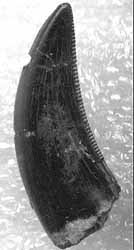
Argentina: Dinosaur Discovered in Patagonia - Named "Small Head" National Geographic - April 2004

Spain: One of the World's 'largest dinosaur' found BBC - March 2004
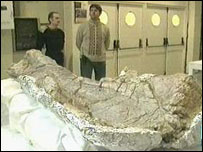
Up to 500 dino species 'undiscovered' BBC - February 2004
Dinosaur fossils found in Amazon BBC - January 2004

The Federal University in Rio de Janeiro said its researchers found the remains of
a new species of dinosaur, estimated to be 100 million years old. The dinosaur is
part of a group of long-necked, long-tailed plant-eaters called sauropods.
Dinosaur family footprints found BBC - December 2003

A rare piece of evidence pointing to a dinosaur mothering her young after
they had left the nest has been discovered on the Isle of Skye.
Ancient pterosaurs 'could have outperformed modern birds' BBC - October 2003

Ancient, Lizard-Like Reptile Discovered National Geographic - October 2003
Numerous 90-million-year-old fossils of a new type of
sphenodontian - an ancient lizard-like reptile thought to
have gone extinct about 120 million years ago except
New dino species found in India BBC - August 2003

New dinosaur identified in South Africa July 2003 - National Geographic
Neglected for 20 years on the dusty shelves of a South African university, paleontologists have re-discovered the 215-million-year-old
fossils bones of one of the earliest giant dinosaurs.
'Cannibal' dinosaur unearthed BBC - July 2003
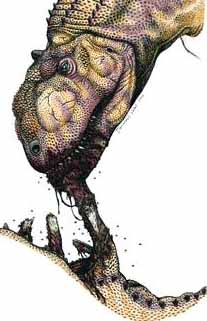
The first clear evidence that some dinosaurs were cannibals
has been unearthed on the island of Madagascar.
Dinosaur Beak Probably Used to Strain Food, Not Kill Prey January 2003 - National Geographic
If the finding is correct, the beaked dinosaurs known as ornithomimids
would be the largest known land-living creatures that filter their food
in eating. Modern-day filter feeders include flamingos and ducks.
Flap over dino flight origins BBC - January 2003

A new theory of how dinosaurs learned to fly has emerged.
Cuba: Dinosaur First Confirmed Remains Discovered December 2002 - National Geographic
England: Remains of Prehistoric 'sea dragon' found BBC - October 2002
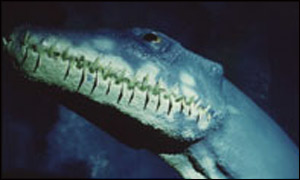
The plesiosaur, which resembles the Loch Ness
monster, dates back to the beginning of the
Cretaceous period 130 million years ago.
"Mummified" Dinosaur Discovered In Montana National Geographic - October 2002
Battle of the sexes 'prehistoric style' - Dinosaurs BBC - September 2002
Dino protein made in test tube BBC - September 2002
Dinosaurs make tracks on the isles BBC - September 2002
Dino family tree shows birds are related June 2002 - BBC

Dino heatwave recorded in leaves June 2002 - BBC
The biggest was not necessarily the best nor the fastest! BBC - March 2002
The most primitive wishbone yet found in a dinosaur BBC - Feb. 2002
Dinosaurs felt the heat BBC - October 3, 2001
How reptiles survived the big one BBC - September 25, 2001
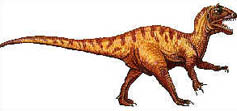
Allosaurus - related to one of the new feathered discoveries
June 18, 2001 - BBC
Scientists in America claim to have discovered two new "bird-like" species of feathered dinosaur, unearthed in New Mexico. The two dinosaurs - the sloth-like Nothronychus and a small carnivore from the coelurosaur family that has not yet been named - lived 90 million years ago in swampy forests.
At that time - the middle of the Cretaceous period of the Mesozoic era - Earth was in the throes of extreme global warming that melted the polar ice caps and dramatically reduced the land area on the planet. Very few dinosaur fossils dating from this period have so far been found.
Nothronychus (pronounced "no-thron-EYE-kus") is a member of the theropod class of meat-eating dinosaurs that includes Tyrannosaurus and Allosaurus, but it apparently evolved into a plant-eater, said Jim Kirkland, a paleontologist with the Utah Geological Survey. The creature weighed about a tonne, was 15 to 20 feet (4.5 to 6 metres) long and stood 10 to 12 feet (3 to 3.6 metres) tall, he said.
Plant-eater
It had two legs and walked more upright than its meat-eating cousins, had a long, thin neck, long arms, dexterous hands, four-inch (10-cm) curved claws on its fingers, a large abdomen, a small head with a mouth full of leaf-shaped teeth designed for shredding vegetation, a relatively short tail and stout back legs, the scientists said.
It is the first example of a group of dinosaurs called therizinosaurs to be found in the Americas. The others all came from China and Mongolia.
No fossil evidence was found of feathers, but Wolfe noted that similar dinosaurs from Asia were found with feathers and speculated that this one had "a loose gaggle of feathers around the head and along the spine, back of the arms and legs".
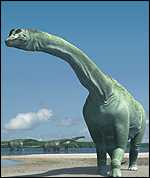
May 31, 2001 - Reuters
Fossilized remains of a gargantuan plant-eating dinosaur, the second most massive animal ever to walk the Earth, have been unearthed in a desert oasis in Egypt at a site that eons ago was a lush coastal paradise, researchers said on Thursday.
The discovery of a partial skeleton of Paralititan stromeri was made by 31-year-old University of Pennsylvania doctoral student Joshua Smith, who went on a dinosaur hunt at a remote site that had yielded spectacular finds in the first half of the 20th century in expeditions led by German paleontologist Ernest Stromer von Reichenbach.
But the fossils of the four new dinosaurs Stromer uncovered were lost to the world during World War Two when British warplanes bombed the Bayerische Staatssammlung museum during a raid over Munich on April 24, 1944. Stromer's excavation site remained largely ignored in the decades since then.
Paralititan (pronounced pah-ral-ih-TY-tan and meaning ''tidal giant'') lived 94 million years ago during the middle of the Cretaceous period of the Mesozoic Era. The long-necked, long-tailed quadruped looked much like the familiar Brontosaurus (formal name Apatosaurus) that lived tens of millions of years earlier, except that its back may have been studded with bony body armor as protection from predators. The large animal might have massed about 70 tons, 75 tons maybe and it might have approached 100 feet in length.
As far as tall, stack four African elephants on top of each other. That's about the height. It would look through a third-story window without much problem.'' The only dinosaur known to be heavier than Paralititan is Argentinosaurus, which looked much like the new dinosaur (both are classified as titanosaurid sauropods) but is estimated to have been about 7 percent more massive. The remains of only one example of these two colossal dinosaurs exist.
Smith found the partial skeleton preserved in fine-grained sediments full of plant remains and root casts in the Bahariya Oasis in the Sahara desert some 180 miles southwest of Cairo.
He said the evidence suggests that the arid Bahariya site once resembled the tropical mangrove coasts of Florida, a low-energy, shallow water area of tidal flats and tidal channels. He compares it to the Everglades. And based in part on Stromer's earlier finding of three massive carnivorous dinosaurs at the site, Smith said the area must have been teeming with life.
Smith believes the massive herbivore was standing on the edge of a tidal channel in very shallow water when it died.
His team also found evidence that the carcass had been scavenged by a flesh-eating dinosaur, including a tooth that may come from Carcharodontosaurus, whose name means ''shark-tooth lizard'' and whose size, 45 feet (13.5 meters) long, was comparable to Tyrannosaurus rex. In addition, the pelvis was ripped apart as if it had been eaten.
It's unclear whether Paralititan lost a life-or-death struggle with the predator or became a meal after dying for other reasons. The skeleton of Paralititan is only 20 to 25 percent complete. Most impressive is a humerus (upper forelimb bone) that measures 6 foot, 7 inches long. The remains also include several vertebrae, ribs and both shoulder blades. The Penn team also found fossils of fish, sharks, turtles, marine reptiles and other dinosaurs.

Experts had thought only herbivores roamed in herds
November 25, 2000 - BBC
Palaeontologists have unearthed evidence in support of a controversial theory: that large, meat-eating dinosaurs hunted in packs.
Experts had always thought that only plant-eating dinosaurs roamed in herds.
The giant herbivores would have lived, walked and died together, based on evidence gleaned from dinosaur graveyards and fossilised footprints.
But now palaeontologist Dr Phil Currie, from the Royal Tyrell Museum, Alberta, Canada, has discovered two fossil bone-beds, buried for millions of years, showing groups of massive carnivorous dinosaurs.
In an interview for the BBC Television series Horizon, he said the new finds were good evidence that huge meat-eating dinosaurs did hunt together in packs.
'Social groups'
The first site, in Alberta, Canada, contained the bones of at least 12 large carnivorous tyrannosaurs, including young and old.
Remains of at least six giant meat-eaters were found at a second bone-bed in Patagonia, South America.
Dr Currie told the BBC: "It seems to me that we have very convincing evidence that large meat-eating dinosaurs formed these social groups where the young and the old worked together, hunted together and lived together."
But some experts remain sceptical. They say that the sites could have been predator traps, where animals sank into sticky molten tar bubbling up from deep within the Earth.
Or floodwaters spreading across the plains could have washed together the remains of several unrelated dinosaurs.
Buried in the same place millions of years ago, the bones might look like a pack when unearthed today.
Angela Milner of London's Natural History Museum said: "A collection of bones in a bone-bed doesn't automatically mean we're looking at a collection of animals that lived together.
"Sometimes bone beds accumulate from large areas of the land where floods have brought all kinds of animal remains together and mixed them up."
The two new discoveries also raise another intriguing possibility. In most parts of the world, the largest meat-eaters and the largest herbivores never walked the Earth at the same time.
The giant long-necked plant-eating dinosaurs died out in the northern continents around 100 million years ago.
But plant-eaters like the massive Argentinosaurus lived on in the South. And recent fossil finds suggest that fearsome predators like Giganotosaurus, bigger than Tyrannosaurus Rex, were also around at the same time in South America.
Bones of the two giants have been found only 80 kilometres apart.
Which means that in prehistoric South America, because of a quirk of evolution, the largest meat-eaters could have fought the largest herbivores in a Clash of the Titans.
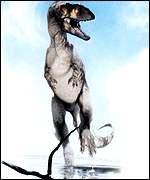
The fierce predator stalked the swamps.
November 10, 2000 - Reuters
Italian paleontogists said Thursday they have identified a new species of dinosaur, which lived 200 million years ago and is one of the oldest meat-eating reptiles ever discovered.
According to fossil fragments found in a quarry in northern Italy, the dinosaur was 26.4 feet long, had a long neck and weighed over a ton, Giorgio Teruzzi, supervisor of paleontology at Milan's Museum of Natural History, told The Associated Press. Each of its sharp teeth measured 2.8 inches, he said.
It is believed to have lived in the early Jurassic era, usually associated with more primitive forms of carnivorous dinosaurs. The Jurassic era lasted from 208 to 140 million years ago.
``It is the world's oldest three-fingered dinosaur, and one of the oldest overall,'' one of the researchers, Cristiano Dal Sasso, said in an interview.
The dinosaur, tentatively called Saltriosaur after the name of the quarry where the fossils were found, is very similar to another predator, the American Allosaur, but is believed to be 20 million years older.
``What's interesting about this dinosaur is that it is more specialized, it is closely related to the more advanced species,'' said Thomas R. Holtz, a paleontologist at the Department of Geology at the University of Maryland at College Park.
The fossils were found entombed in a limestone block in a quarry in Saltrio, north of Milan near the Swiss border, in 1996. Researchers started studying them only last year.
They include more than a hundred bone fragments, the longest measuring 16 inches - altogether less than 10 percent of the entire skeleton. One tooth was also found.
Holtz said that 200 million years ago was a critical time for the evolution of meat-eating dinosaurs. It was then that they started evolving into truly fierce predators.
``This specimen will be helpful in terms of the reconstruction of the dinosaurs' history and interrelations between various groups,'' Holtz said.
The Saltriosaur fossils will go on display Friday at Natural History museums in both Milan and Besano, near the quarry.
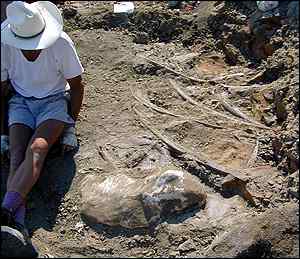
C-rex could be even bigger than Sue
Oct. 10, 2000 - BBC
The discovery of five Tyrannosaurus rex skeletons during a single summer dig in the United States could mean these creatures were more common than previously believed, according to the leader of the project.
One of the huge, carnivorous dinosaurs could also be the largest specimen ever found.
Jack Horner, head of palaeontology at the Museum of the Rockies in Montana, US, described his team's finds as very unusual.
"On average, a T. rex is discovered once every 10 years," he told BBC News Online. "To find five in one summer in one area is very surprising."
Only 20 confirmed T. rex skeletons have been uncovered to date.
Horner, who acted as adviser to Steven Spielberg on the Jurassic Park films, is not willing to be drawn into immediate conclusions about the scientific significance of the discoveries.
Dinosaur evolution
But he concedes that it might mean the huge beasts were more common than previously believed.
The remains were found between June and September this year in the Fort Peck Reservoir area of Hell Creek, Montana. The area is a famous dinosaur hunting ground.
It has rocks that cross what is known as the K-T boundary, the layer where dinosaurs vanish from the geological record about 65 million years ago.
Horner and his team are involved in a five-year survey of the dinosaurs, mammals, invertebrates and fossil plants found in the region.
But they deliberately set out to look for creatures that lived long before the mass extinction - well below the K-T boundary.
Largest ever
"Most people have been interested in the extinction of dinosaurs, but I'm more interested in how they lived and evolved," he said.
Most of the Tyrannosaurus remains have not yet been fully uncovered. Parts of three skeletons and most of a fourth have been removed so far. The rest will be extracted next summer.
There is great excitement about one of the specimens in particular. This was discovered by Horner's wife, Celeste, in July.
The skeleton is only partially intact, but the jaw and a few cervical ribs removed late in the digging season seem to indicate that C-rex (as it has been dubbed) could be the largest T. rex ever found - bigger even than Sue, which drew huge crowds to the Field Museum in Chicago when it was put on full public display for the first time in May.
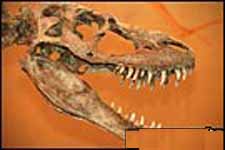
Albertasuarus
Sept. 14, 2000 - AP
Scientists have argued for years whether dinosaurs were warm-blooded, like birds and mammals, or relied on the sun for warmth, as do cold-blooded reptiles. Lack of direct evidence, such as well-preserved organs, makes it a difficult question to answer.
However, geochemist Henry Fricke has found another way to tackle the problem; he studied the oxygen chemistry of fossilized dinosaur and crocodile teeth. Fricke discovered that the body temperature of meat-eating dinosaurs appeared warmer than cold-blooded crocodiles.
"The biggest impact this might have involves figuring out where dinosaurs fit evolutionarily in relationship to birds and reptiles," he said.
Using oxygen chemistry also provides a new line of evidence in the warm-blooded vs. cold-blooded debate. Fricke, now at Colorado College, performed the work while at the Carnegie Institute of Washington. He and co-author Raymond Rogers of Macalester College present their results in this month's issue of the journal Geology.
Analyzing oxygen chemistry is a popular method for evaluating ancient climates and fossils, but Fricke is the first to try the method on dinosaur teeth.
Oxygen atoms can have three different masses, known as isotopes. Scientists know that rainwater at higher latitudes contains more lighter oxygen isotopes than rainwater at lower latitudes.
Previous studies have shown that rainwater's isotope ratio affects the ratio recorded in tooth enamel, since animals drink rainwater. But a cooler body temperature skewers the ratio.
Fricke and Rogers studied 75-million-year-old teeth from crocodiles and three dinosaur species -- Albertasaurus, Majungatholus and Saurornitholestes -- that lived in a wide range of latitudes.
Fricke found that overall, the teeth of all the species studied reflected the rainwater ratio of the latitude. But he was surprised to find the crocodile teeth had slightly lower levels of lighter isotopes than the dinosaurs.
Body temperature is why, says Fricke.
This indicates the dinosaurs may have been internally regulating their body temperature, like warm-blooded mammals, he says.
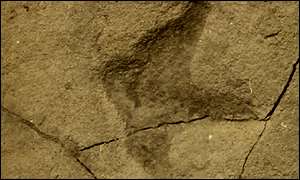
Tracks suggest Italy was not an island
August 22, 2000 - BBC
Fossil tracks found in Southern Italy suggest the Italian peninsular was connected to Northern Africa during the reign of the dinosaurs.
A hundred and thirty million years ago a group of dinosaurs walked across a muddy plain, leaving a trail of sixty massive footprints behind them.
The tracks solidified into rock - and have just been uncovered by a team of geologists from the University of Ferrara in Italy.
Some of the footprints have been identified as belonging to an Iguanadon, a nine metre long, five-tonne dinosaur.
The herbivorous creature is similar to dinosaurs that lived in North Africa - and this suggests that Southern Italy was connected to Africa a hundred and thirty million years ago.
Geological evidence supports the idea that Italy and north Africa are made from the same rocks - but up to now it was thought that the Italy of today was just a group of islands off the African coast.
But giant dinosaurs like the Iguanadon could not have survived on small islands - so the footprints are strong evidence that Italy was part of continental Africa.
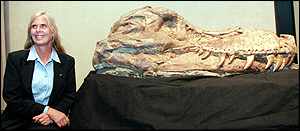
Sue and Sue: Hendrickson unearthed the dino in South Dakota
May 17, 2000 - BBC
The monster specimen known as Sue, after the fossil hunter Sue Hendrickson who discovered it, takes centre stage at Chicago's Field Museum after extensive preparation.
The dinosaur, which was unearthed in South Dakota's Black Hills in 1990, cost the natural history museum $8.36m at an auction that had been delayed for years by a drawn-out legal battle that ended with Hendrickson's partner in jail.
To cover the cost of the 67-million-year-old carnivore, the Field has taken on two major corporate partners in McDonald's and Disney.
The two organisations share exclusive rights to casts of Sue's bones; the museum keeps the real ones, which have been put up in its main hall.
Sue's one tonne skull, too heavy to be mounted with the rest of the skeleton, will be displayed in a case nearby. A lightweight cast will replace it on the skeleton.
Longest tooth
"People, in all the alternatives they have in computer games, shopping, the internet... love real things,'' Field President John McCarter said.
Sue - palaeontologists are not sure whether this dino is male or female - is 12.5 metres long (41 feet) and about four metres (13 feet) tall at the hip.
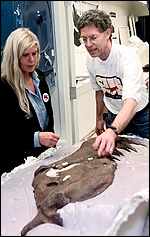
Sue Hendrickson watches restorers as they make a cast of the lower jaw of the dinosaur
At 85-90% complete, Sue is the most comprehensive T. rex ever found, and has one of the only two T. rex arms ever to be discovered.
Sue can boast the longest tooth yet found for a T. rex, measuring 30 centimetres from root to tip.
Fewer than 25 such carnivores have ever been unearthed. "You can't do anything with a fossil till you know what's there," says palaeontologist Chris Brochu, a research associate at the Field and the lead researcher on the dino. Some details of Sue's skeleton may reveal more extraordinary events in her life. A number of her bones show pathologies; there are holes, scars, masses, and even two misshapen teeth.
A number of the wounds were at first thought to be bite marks and battle scars. But Chris Brochu, after consulting with a palaeopathologist (a scientist who studies disease and injury in fossils and other remains), now thinks most of the lesions were probably caused by infections.
"What's interesting is that Sue didn't die from any of these wounds. They all show extensive healing, a sign of good health. At this point it looks like Sue lived a good, long life - and then she just died."
May 7, 2000 - Nando
Time and archaeological graverobbers are finally taking their toll on a prehistoric gem that has withstood millions of years of geologic upheaval.
Within a month of the chance discovery of the fossilized remains of a mastodon in late March and before excavation could begin, looters had moved in, taking some artifacts and damaging others.
Tom Lugaski, director of the W.M. Keck Museum at the University of Nevada, Reno, is optimistic they left the best stuff behind.
"It's like Christmas time with all these packages around here," he said as the dig got under way at the end of April.
To his right, a shallow pile of crushed ribs bore testimony to the work of vandals. But to his left, some 20 scientists, students and volunteers picked and chipped around the partially exposed leg of the creature, which roamed what was then a marshy western Nevada some 3 million to 3.5 million years ago.
The surprising find was made at the end of March by two teen-agers who were riding motorcycles in the steep and rocky canyons of the Pine Nut Mountains.
Derek Prosser and Dustin Turner not only recognized the object sticking out of the rock as a large bone, but reported their find to the federal Bureau of Land Management.
Prosser, 18, said he had seen enough bones to know these weren't just an outcropping of rock, especially when he spotted the crystallized marrow.
"After taking a close look, it kind of shocked me. I knew it was something very unusual," he said.
The boys took some specimens to the bureau.
"They did everything exactly right. We're lucky they found the bones and even luckier they reported it," the bureau's historical archaeologist Gary Bowyer said. The find is on BLM-administered land.
Despite the rugged remoteness of the site, word leaked out of its whereabouts and there have been signs of non-scientific exploration, Bowyer said. That put pressure on the experts to interrupt their Easter weekend before there's any lasting damage.
"This is an emergency excavation," he said.
Using tools ranging from pressure bars to hammers and chisels to soft brushes, workers hunkered down in a pit about 10 feet in diameter to remove the fairly soft sandstone from around the buried bone.
"We have the front leg, from the shoulder down to the foot," Lugaski said. "At this point, we don't know if there is any more that we can see. It would be nice if we could find the whole thing, but they die and disintegrate."
He said the foreleg alone is a rich reward.
"Most often, you'll get a piece of tooth, a piece of leg bone. A whole front leg starts to get fairly rare. What's important is they're finding more and more pieces of it."
A fist-sized chunk of skull and the fragments of rib bones leave Lugaski optimistic that more work will unearth discoveries that range beyond just the leg.
"Hopefully there'll be some more out there. It could be scattered over hundreds of feet. You never know," Lugaski said.
The dig is on hold until workers remove dirt and rocks the centuries have deposited in the rocky canyon uphill from the excavation.
The paleontologically rich area already has yielded remains of camels, horses and extinct bears, which help establish the date of the American mastodon as being at the upper end of the species' reign in North America. They first appeared about 3.75 million years ago and abruptly disappeared 10,000 years ago at the beginning of the Ice Age.
A youngster had little trouble gathering ancient non-mastodon teeth lying on the steep hillside above the dig to turn over to the researchers. Walking off with archaeological trophies can bring a stiff fine.
The site now almost exactly one mile above sea level originally was some 700 feet lower and was much wetter since the Sierra were still forming and Pacific storms could easily cross into the valley, according to Pat Cashman, an associate professor of geology at UNR.
The climate encouraged the growth of shrubs and small trees in great enough abundance to keep the elephant-like animals well fed.
"They'd clear off this whole hillside in no time today," Cashman said, gesturing toward the spotty growth of juniper and sagebrush.
Mastodons were smaller than their towering relatives, the mammoths, and were squatter and longer than modern elephants, averaging 6 feet to 10 feet at the shoulder and about 15 feet from the root of the tusks to the start of their tail. They were covered by a coarse, reddish-brown hair.
The age of this mastodon makes it a rare find but also makes radioactive carbon dating impossible since that is accurate only to about 500,000 years, according to UNR graduate student Tom Mantean. Other dating methods and fossilized material around the excavation will make more accurate dating possible as the remains are studied in greater detail at the university.
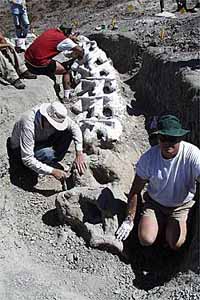
January 7, 2000 - AP
Texas paleontologists have discovered a hulking giant of a dinosaur with a neck more than 30 feet long and a vertebra weighing up to 1,200 pounds. The researchers say the fossil is probably by far the largest dinosaur ever found in the Lone Star State.
"This thing is just bloody enormous," says Homer Montgomery, a paleontologist at the University of Texas at Dallas, who along with his students found the creature in a wilderness area of South Texasí Big Bend National Park last fall.
Montgomery and his team were able to haul out the two smallest cervical, or neck, vertebrae -- one weighing 367 pounds and the other 470 pounds -- by hand before leaving the dig for the winter.
Most of the creature remains in the ground near an established bone bed full of juvenile Alamosaurus remains dating to the Late Cretaceous, only a few million years before dinosaurs died out.
Alamosaurus, part of a dinosaur family known as titanosaurs, was the last of the long-necked dinosaurs called sauropods to roam North America, but is so far known only from scattered and broken remains. The 23-foot length of the new dinosaurís neck may represent the largest intact section of the largest Alamosaurus ever found.
But its monstrous dimensions also suggest that it could be an entirely new species that exceeds the accepted 70-foot length of Alamosaurus adults by some 30 feet, Montgomery says.
"We know so little about this dinosaur that any find is important and something this large is doubly so," says Tony Fiorillo, a paleontologist at the Dallas Museum of Natural History who has also worked in Big Bend.
Montgomery plans to return to the remote desert site in February to remove more of the 10 vertebrae his team has already exposed and to excavate ribs and other bones protruding from the ground.
As the largest of the vertebrae measures more than five feet across and weighs about 1,200 pounds, a helicopter may eventually have to airlift the ancient creature out of the wilderness, says National Park Service geologist Don Corrick.
CRYSTALINKS MAILING LIST, NEWSLETTER, UPDATES